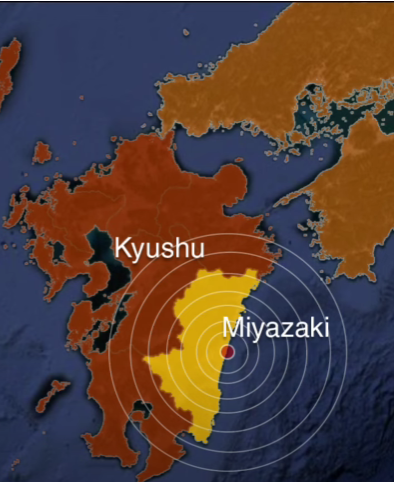Tokyo, Japan – Japan was shaken by a powerful 7.1-magnitude earthquake off the southern coast on Thursday afternoon, prompting the Japan Meteorological Agency (JMA) to issue its first-ever warning for a potential “megaquake.” The earthquake occurred at 4:42 p.m. local time (3:42 a.m. ET) near the coast of Miyazaki Prefecture on Kyushu, one of Japan’s main islands. The quake struck at a depth of approximately 18 miles, sparking immediate concerns about the possibility of a much larger seismic event.
Immediate Aftermath: Tsunami Advisory Issued
In the immediate aftermath of the earthquake, authorities issued a tsunami advisory, urging residents in coastal areas of Kochi and Miyazaki prefectures to evacuate to higher ground. The JMA reported that tsunami waves of up to 1.6 feet were observed along parts of Kyushu’s southern coast and on the nearby island of Shikoku approximately 30 minutes after the earthquake. Miyazaki Port recorded a surge of 20 inches, according to Japanese broadcaster NHK.
While the tsunami waves did not exceed 1 meter (3.3 feet), which is generally the threshold for more severe advisories, the warning served as a stark reminder of Japan’s vulnerability to seismic activity. The advisory was eventually lifted, but the region remains on high alert.
Damage and Injuries Reported
Although the earthquake caused no immediate catastrophic damage, several incidents were reported in the affected areas. Police in Miyazaki Prefecture received 10 reports of damage, including landslides and malfunctioning traffic lights. In Kagoshima Prefecture, a concrete wall collapsed, and a wooden house sustained damage.
Three injuries were reported, all involving women. Two elderly women were taken to the hospital after falling, while a female factory worker was injured by a falling object. Despite these incidents, there were no reports of widespread blackouts or damage to water or communication systems.
The Nuclear Regulation Authority confirmed that all 12 nuclear reactors on Kyushu and Shikoku islands were unaffected by the quake, ensuring the safety of these facilities. This is a significant concern in Japan, particularly in the wake of the 2011 Fukushima disaster, which was triggered by a massive earthquake and subsequent tsunami.
The Megaquake Warning and Its Implications
Following the earthquake, seismologists and government officials held an emergency meeting to assess whether the seismic activity could lead to a larger, more devastating event. The JMA issued a “megaquake caution,” indicating that while the possibility of a larger earthquake is higher than usual, it is not guaranteed to occur in the near future.
Prime Minister Fumio Kishida addressed the nation, urging citizens to stay vigilant and prepare for the possibility of further seismic activity. “We ask all citizens to carefully check every new information issued by the government, reconfirm their daily earthquake preparedness, and be ready to evacuate immediately in the event of an earthquake,” Kishida said in a news briefing.
The JMA’s warning has heightened concerns among the public, particularly given Japan’s location on the Pacific “Ring of Fire,” an area known for its frequent and often powerful earthquakes. Japan experiences thousands of earthquakes annually, though only a small percentage are felt by the population. The country’s advanced seismic monitoring systems and stringent building codes have helped mitigate the impact of these natural disasters, but the threat of a “megaquake” remains a significant concern.

Historical Context and Preparedness
Japan’s history is marked by devastating earthquakes, including the 2011 Tohoku earthquake and tsunami, which claimed over 15,000 lives and caused the Fukushima nuclear disaster. The potential for another large-scale earthquake looms over the nation, particularly in regions like the Nankai Trough, a tectonic plate boundary that has produced some of Japan’s most powerful quakes.
The Japanese government and local authorities regularly conduct disaster preparedness drills and maintain strict building regulations designed to withstand earthquakes. Citizens are encouraged to keep emergency kits and have evacuation plans in place. Despite these measures, the unpredictability of earthquakes means that the risk can never be entirely eliminated.
Looking Ahead
As Japan braces for the possibility of further seismic activity, the government continues to monitor the situation closely. The JMA has urged residents in the affected regions to remain alert and follow any new advisories or evacuation orders.
The earthquake serves as a reminder of the ongoing challenges Japan faces as one of the world’s most earthquake-prone countries. With its advanced infrastructure and disaster preparedness strategies, Japan remains resilient, but the ever-present threat of a megaquake requires constant vigilance and preparedness.
For now, the nation waits, hoping that the recent tremor was not a precursor to something more catastrophic but remains prepared for whatever may come.






One thought on “Japan Issues Megaquake Warning Following 7.1-Magnitude Earthquake off Southern Coast”